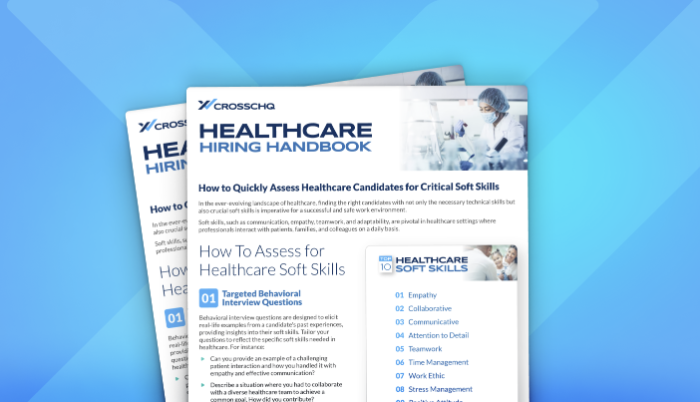

Crosschq Blog
How Internal Referrals for Candidate Sourcing Can Tank Quality of Hire

Examining source-of-hire statistics to see where the best (and worst) new employees come from can be an interesting journey. It can also inform the strategy for recruitment going forward, positively impacting the business by lowering recruitment costs and improving Quality of Hire.
When new hires from a specific source are consistently shown to be high or low value, the appropriate action to take is to shift both budget and effort from the low-performing recruitment channel to the high-performing one.
However, it’s not just external candidate sources that need to be evaluated for cost-effectiveness and new employee value. A surprising fact being unearthed as more and more companies measure Quality of Hire is that the internal referral shouldn’t be used as a golden buzzer when it comes to selecting talent.
Breaking: Internal Referrals are NOT The Best Source of New Hires
Currently, U.S. employers get 30% to 50% of their new hires from referrals. However, Crosschq Data Labs found that internal references for open jobs do NOT correlate with a successful hire based only on performance data.
Internal hires may demonstrate great team fit, but they are less likely to improve diversity or creativity. In fact, data from The Crosschq Q (Quality of Hire) Report revealed that Quality of Hire for internal referrals was 26% below the industry mean.
Additionally, among internal referrals and employee transfers, the average tenure is more than 41% longer than those from all other candidate sources. While retention is important to prevent loss of productivity due to employee churn, holding on to a low-value hire can cost even more in the long run.
What is a Successful Hire?
Defining what the term “successful hire” means to an organization is critical to avoid muddying what Quality of Hire is; retention is important, but is it more important than performance? It all comes down to the value an employee brings to the table, both short- and long-term.
A high-value hire results in an employee that ramps up quickly, has high employee engagement, and meshes well with their department and team. A high-value employee should be nurtured to increase their value through retention, but retention alone doesn’t make for increased Quality of Hire.
Understanding Quality of Hire impacts not only recruitment but the assessment of the current workforce. Organizations that can identify and remove low-value employees make room for high-value ones and improve their company’s productivity, creativity, and revenues.
Why Internal Referral Hires Can Backfire
Many companies still believe that internal referrals are one of their highest-performing sources of candidates, and this may be true - especially if the measurement of success is focused on speed of hire and applicant-to-offer metrics. However, that’s a far cry from the actual Quality of Hire, which is how the employee brings value after they begin employment.
There are a number of contributing factors to poor hires coming about as a result of internal referrals. The top two are:
1. Less scrutiny in the recruitment process leading to missed red flags
In most cases, members of the hiring team will typically carry out a selection process that displays less scrutiny when it comes to evaluating internal referrals compared to the scrutiny applied to outside applicants.
This failure to complete due diligence can result in the hiring or promotion of an individual who looks good on the surface but lacks the necessary skill sets and attributes to fit into the team being supplemented.
It’s best to put internal referrals through the same stringent screening process as any other candidates. This should include the completion of a candidate reference check using Crosschq 360 to build a profile of each applicant which can be fairly compared with the rest of the talent pool.

2. Referral incentives skewing the quality of candidates being hired
The referring party may also recommend candidates with less than ideal-qualifications for an open job simply to access an economic incentive. These types of referrals can have a negative impact, often resulting in the loss of the new hire just after a specified time period for the incentive to kick in (often 60 or 90 days after hire.)
Losing a fresh employee at this stage means the time , effort, and expense of filling the seat is now lost and the process of recruitment must restart. Runners-up for the position will be unlikely to remain receptive after a wait of several months.
While workers who apply as internal referrals do have some benefits (time-to-fill among them), the risk of low Quality of Hire should make organizations think twice about giving undue preference to candidates sourced in this way.
Using Crosschq Analytics can help hiring managers build profiles of ideal employees based on existing data on existing workers, and all candidates should be compared to top key performance indicators to help with the candidate selection process.
Where Should Organizations Look for High-Value Employees?
Employees with high Quality of Hire scores can be expected to provide more value to the company’s bottom line. Correlating the Quality of Hire scores of your best employees with the source from which they were hired can provide insights into the value of each candidate source.
According to Crosschq Data Labs research,
- Recruiter and agency-sourced employees typically had average Quality of Hire scores above the mean
- Job boards and social media-sourced employees usually had Quality of Hire scores below the mean
- Internal referral candidates typically had Quality of Hire scores that fell 26% below the industry mean
This can vary from company to company, of course, and not all candidate sources will consistently bring in high-quality or low-quality talent. Other factors can come into play, including the quality of the job descriptions, recruiter expertise, and hiring manager responsiveness.

Some candidate sources are fairly inexpensive, while others add to the average cost to hire. However, the added cost can be well worth it if the Quality of Hire increases across the organization.
It is critical for companies to measure all candidate sources against outcome data, including internal referral programs which may be incentivizing poor referrals and hires based on assumptions instead of data.
Outcome-based analytics mitigates referral bias and prompts organizations to make evidence-based decisions. Using Quality of Hire as the benchmark to determine each employee’s value and each candidate's anticipated value is the best way to zero in on candidate sources that consistently bring in top talent.
If internal referrals are enriching an organization, it’s likely due to having good processes in place already which have ensured a high Quality of Hire across existing employees. If this is not the case, consider investing budget into better-performing candidate sources to improve the value of your talent pool.
To learn more about how Crosschq can help identify top candidate sources for employee Quality of Hire, contact us for a demonstration today.
Take the Guesswork
Out of Hiring
Schedule a demo now



%20-200x43.png)






